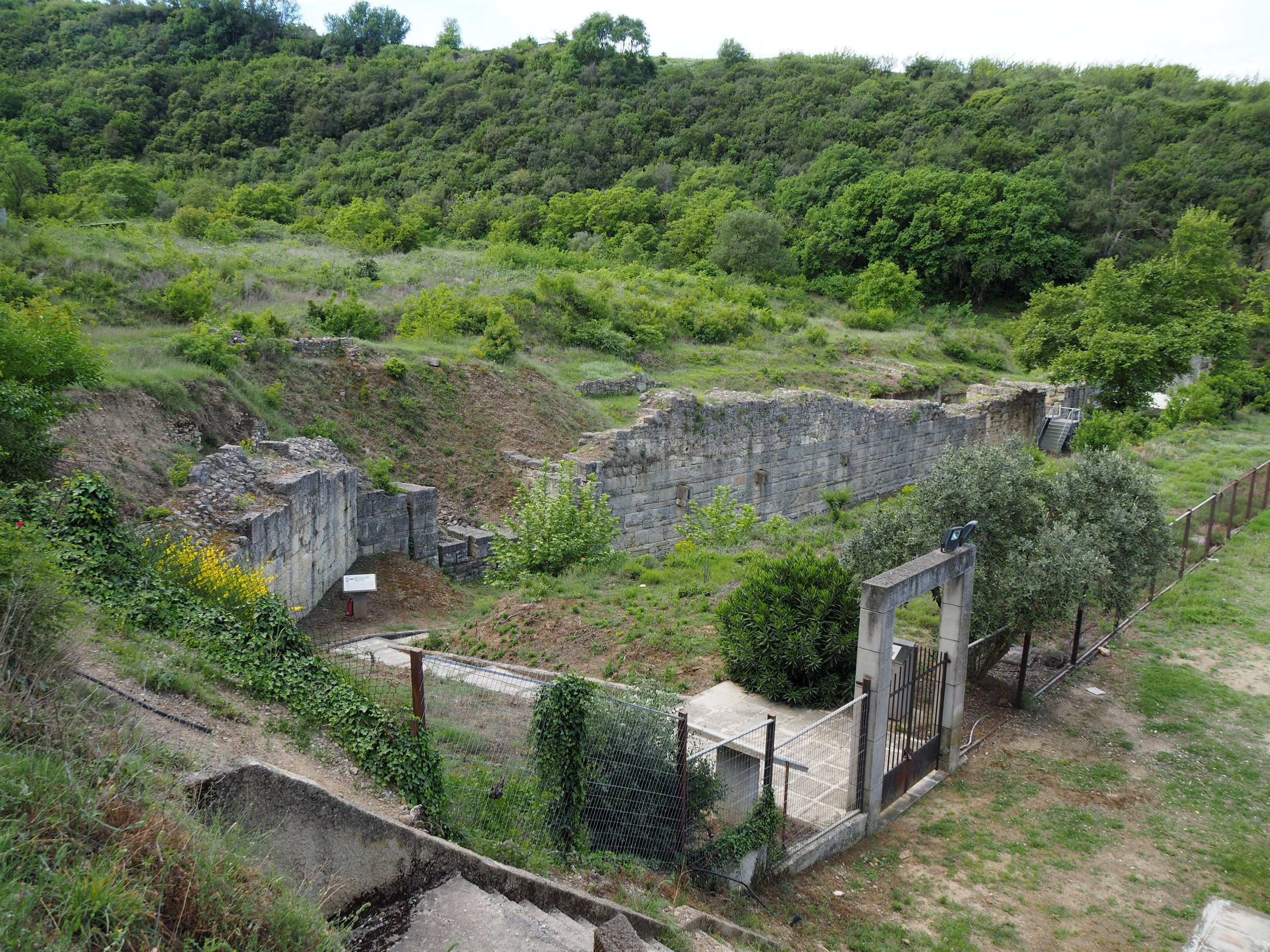Albania and Greece 2024
This years trip with my mother was to Albania and also Thessaloniki, Greece. We chose this area because, well, not too hard to get too but also there was archaeology we haven’t investigated. It ended up being a pretty great trip, with a few bumps along the road. All in all, I’d recommend both of the areas. When Albania is a crazy expensive place to visit by 2034, don’t blame me.
Near Athens
We flew through Athens on this trip, which ended up not being great on the flight back. But we stayed at Apartments Tina, a short drive from the airport. It was nicely inexpensive and the room was fine for a break in between our flight to Athens and our flight to Tirana. The only downside was that the free shuttle to the hotel from the airport was really delayed and it was kind of frustrating.
But the best thing we did on the layover was to go to the sanctuary of Artemis at Brauron. It’s a short drive from the airport or hotel, and it’s a lovely site with a nice museum and a really fun site. I haven’t visited many sanctuaries of Artemis, so this was fun, and it was historically tied to a temple dedicated to Artemis on the Acropolis of Athens. They had a huge processions from the temple to the sanctuary every four years, so it was important. They found a lot of good archaeology and it’s a nice visit. I mean, if it’s your first visit to Athens, you probably have other sites to visit, but for our third time in the area, it was nice and much quieter than the rest of the city.






Tirana
Another gem of a city that we were surprised by. It is a very impressive city, and they have a lot of great restaurants and parks and I highly recommend it. Once again, it’s not the easiest to get to from the US - we did a direct to Athens from New York and then a layover and a flight from Athens to Tirana. But the Tirana airport is pretty nice and you can get there from a number of European cities.
We didn’t have a lot of time there on our way to Vlore, but it was worth it. The National Archaeology Museum is pretty nice. It’s a little outdated in the way they display and present the artifacts, but the artifacts are good and the layout is really nice. We actually had a kind of free private guide from one of the museum’s directors because we asked some good questions when we bought tickets from him (from his office around the corner from the main check-in - we were behind a large tourist group and so we got shuffled there.) He gave us a great overview and answered all of our questions, which was great! They have some really interesting early pottery that I didn’t recognize, and we also got a good idea of the sites we were going to in the rest of the trip.
We next went up the park to the National Ethnographic Museum, or just the National Museum. The lower level had recently been redone and it’s pretty good. But there’s a lot in the upper levels that looks like it was done well but it was all in Albanian, so we didn’t understand a lot. I know that I’m a lazy American tourist, but since English is the most common second language in the world, it’s nice to see the info in English. And they had English in the lower level. But it’s fine and it’s in a nice museum building.
The city is really easy to navigate if you’re staying in the central area. I recommend visiting the castle, which isn’t much of a castle but is a super cute restaurant/shopping area. The pyramid is very famous and a lot of people stop there to take photos. But it really is a nice, comfortable city.
We picked up our rental car from Green Motion. It would have been easier and better if we had known they moved across the street, but other than that, it was fine. If you do rent from a car rental that is across the street, I’d recommend heading away from the car rental area next to the airport since you have to go around the fence, and the sidewalk that direction is much easier than going the other way.
We then went to Durres to see their theater and we encountered our first major issue in Albania - parking. There is a public parking place near a KFC and the waterfront, but it was hard to find. The road has a no parking sign on it, not a no entry sign but it’s hard to remember. We ended up missing it the first round and drove around a bit until we went back and figured it out. Navigate to the Luna Park, and go down that road even though it seems like it isn’t a thing.
Unfortunately we were late getting to the theater and we couldn’t go in, but the view from above is lovely. The city itself has a Roman baths, Venetian walls, and a bunch of cute stuff. So, worth a quick visit if you can find parking. We then proceeded south to Vlore.





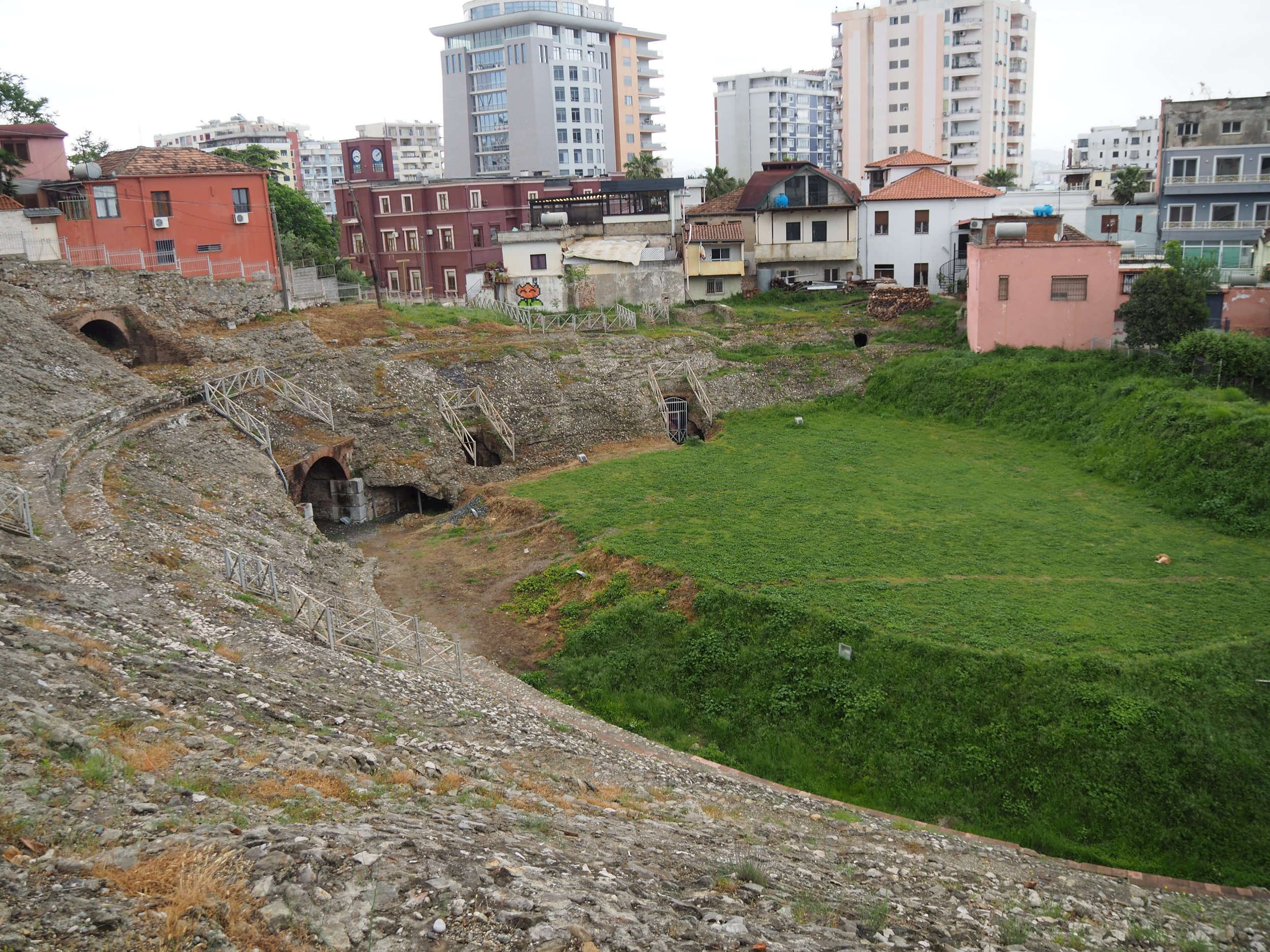








Vlore
I would say that Vlore was probably my favorite place we stayed in Albania. It’s a wonderfully central location and isn’t quite as overdone as further south. There’s a really cute old part of the town that is definitely worth a visit. And of course, an excellent place to get to some really good archaeology.











Tips and Tricks
Vlore, the town itself, has some very cute parts. We stayed further south than the main body of the city, which was good for parking. While it wasn’t as historical, we really enjoyed the location and there were lots of restaurants within easy walking distance. It also helped that we had access to a parking garage - something that is a must in the city.
There are quite a few places to visit within a relatively easy drive from Vlore. We started at Orikum. Orikum was really fun. One of the weirdest things about it is that is on the land of a naval base, so you can’t just drive to the site. You have to go through the gates and have your passport checked by an official. So, here’s my advice. Definitely go - it’s not a huge site but it’s very charming and quite pretty. Its location right by the water makes it a really nice visit. If you follow Google Maps, you’ll have no trouble getting there, just make sure you bring your passport! You’ll start at the entrance gate for the site where you’ll pay for the entrance, and then hand over your passport to the guard on duty. After you get through, you drive for a while and you’ll see a sign for the site on your left. Drive up as far as you can go. You can park either near the water (which we did) or go further up. I’m glad we parked at the bottom, though, because there’s some useful information about the site. It’s a lovely site to wander, though it isn’t too well marked. All of the sites we visited were either Illyrian or Greek, though this particular site was also occupied by the Romans for a time. But it has the same basic layout as many of those sites. What makes this different from most of the Illyrian sites was its location by the water. Most Illyrian sites are on hills, but the major development of this site was under the Greeks, so it makes sense. It was eventually conquered by the Romans, and actually was seized by Caesar during his war with Pompey. It was a useful port and naval base.
From there, we took an inland route to Byliss. We really should have gone to the main road and then up, but we decided to follow Google Maps that took us on a road that seemed fine and first but turned out to be under construction. That was a bit rough.
Byllis is an Illyrian site on the top of a hill. There is actually a very well-paved road (probably recently redone) that leads up from the main highway, but we didn’t know that until we got there. But we took it down!
It’s an amazing site. Don’t park near the gate - it’s a really long walk to the main site. Drive all the way down the path and then you’ll see a parking lot on your right. It’s right across from the entrance where you’ll pay to go in. It’s really an amazing site. The views out are spectacular, and the site itself is very well marked and easy to navigate. The layout is pretty standard for Greek-type setups. The site was originally Illyrian. It has these massive perimeter walls which are really well preserved. There are also the remains of a basilica from the late Roman period. It’s a pretty stunning city and worth it for the views alone.
From there, we went down the nicely paved road (check the maps for the route with the fewest tight turns to find the easiest way down to the main road) and on to Apollonia. Apollonia is probably the largest site we visited in the area. It had been a major port and is located toward the shore. There are two entrances from the highway, and you need to take the first if you’re coming from the north or the second if you’re coming from the south. You can take the other route but it leads to the overflow parking which would be a bit of a hike from the entrance.
The Apollonia site has a very nice little museum with some finds. It’s located in the old church buildings, and there is also a nice old church you can visit. The site itself is pretty sprawling. The routes are a little hard to figure out, and the site had been damaged by the military, but it is still quite impressive. There are the remains of a monumental building from the 2nd century that are pretty well preserved, and the nice remains of a theater. If you can guess from the fact that this is on the coast, it was a Greek settlement instead of Illyrian. It had been settled by people from Corinth but eventually gained independence. It was also a prominent city during Roman times. Augustus (the first Roman emperor) actually studied there. It was really damaged by earthquakes and eventually abandoned. But it’s really lovely now, with an excellent little restaurant near the entrance where we had a nice late lunch. Great house wine!
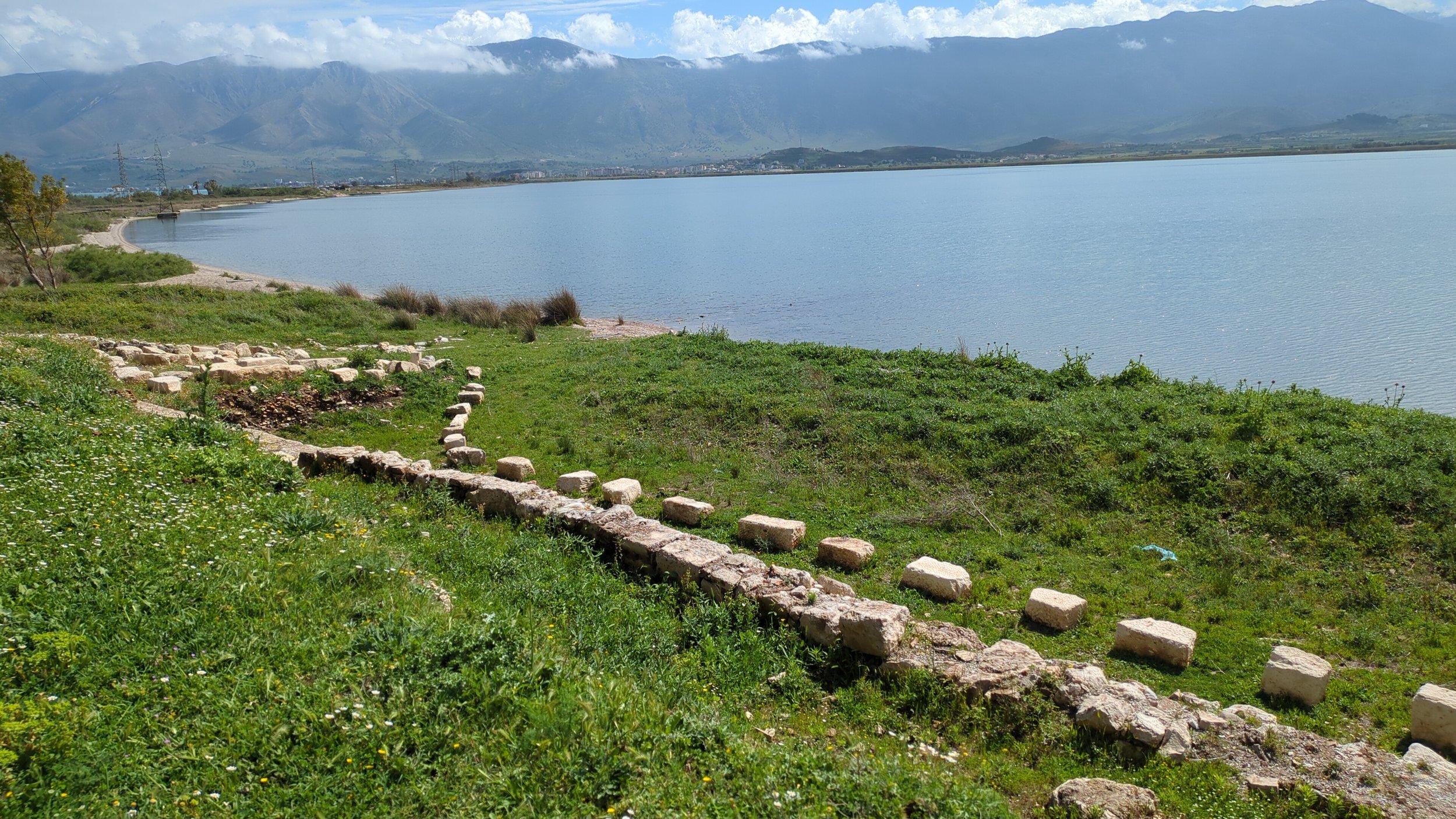
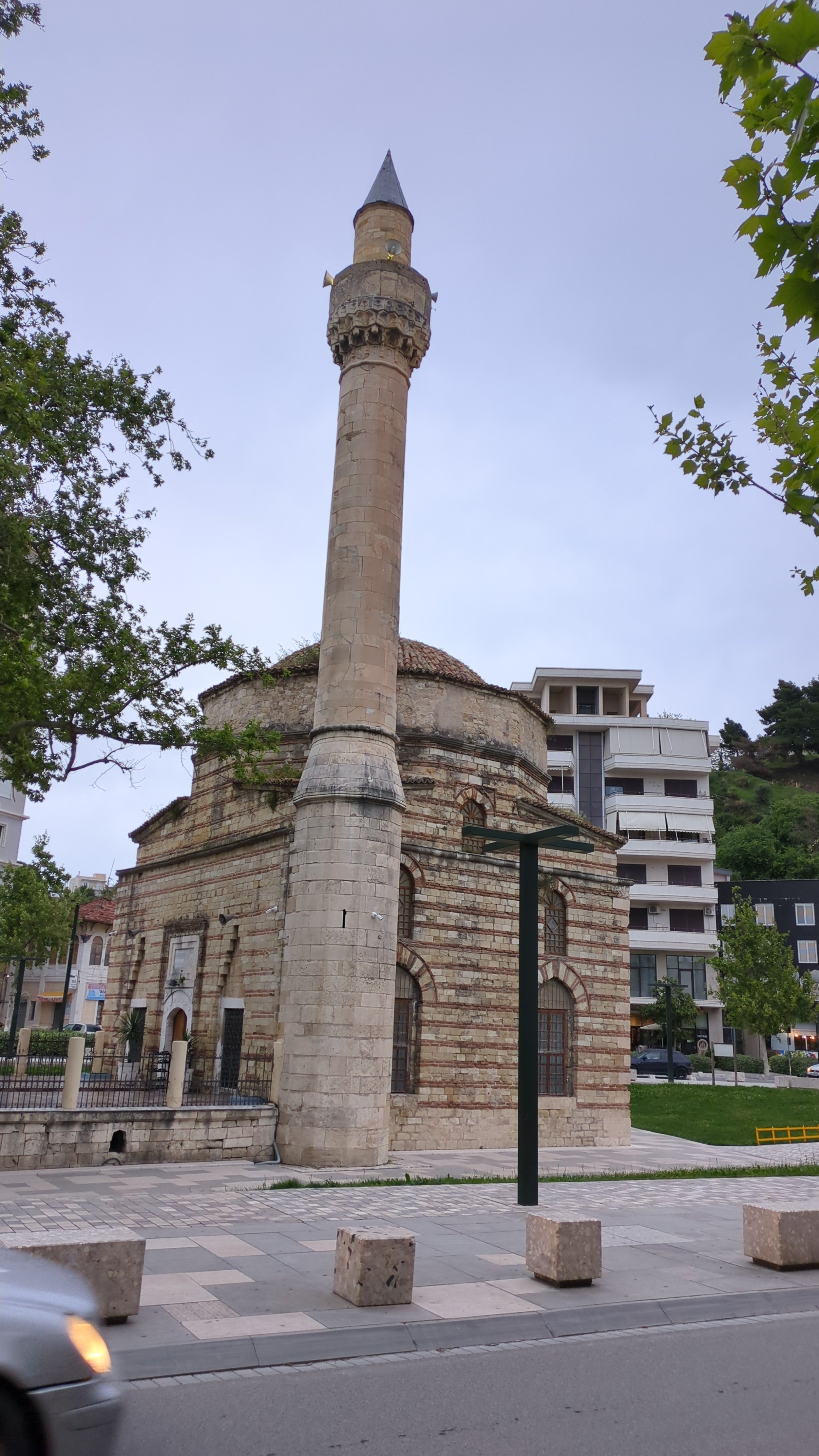









Butrint
Butrint is the UNESCO world heritage site in Albania, It’s really impressive and quite worth the visit.
We visited Butrint on the day we traveled from Vlore to Sarande. When you get to Albania, you will have the coastal road recommended for its incredible views, It does have great views and goes through a national park. But it’s also very windy and a little nerve-wracking in places. We had originally planned a few other sites on the day down to Sarande, but it was such a difficult drive that we decided to just do the one. It’s really worth visiting, and very easy to get to.
Butrint is right along the main road that, if you keep following, will take you to Greece. The funny thing about this main road is that it takes you to a river that you’d have to cross to continue, but instead of a bridge like most countries would have, it as an old ferry that can hold about 6 cars at most. You can ride across as a pedestrian (for free) and visit the Venetian triangular castle. You can’t go inside, but it’s a nice visit and it’s fun to ride the ferry.
The site itself is quite large and has more infrastructure than others because it was also populated by the Venetians. So there are Greek, Roman, and Venetian remains on the site. The most noticeable of the Venetian remains would probably been the castle on the top of the hill, taking over the location of the ancient Acropolis.
I would say that the site is best divided in the lower and upper parts of the site. The low parts of the site include some really impressive remains of large houses, an amazing theater (which has inscriptions along the base about slaves that were freed,) and the remains of a basilica. If you follow the path around, you’ll go around the inner wall, and you can come to an entrance that allows you to go to the upper part of the site. The entrance is really cool in that it has been altered to have a really low lintel, meaning you have to crouch to go through. There’s also the remains of a well with some pretty decoration right by the stairs. You can follow the path up to the upper part and visit the museum in the old Venetian castle. There isn’t as much to see in the upper part of the site, but you do get some pretty incredible views.
The only downside to the site is that it is subject to some pretty severe water issues. This did give me my first archaeology frogs, which were very cool. But the main road by the theater is underwater as are parts of the large ancient house. There are remains of walls along the outer perimeter of the lower part of the site that have some pretty cool entrances.
It’s a really lovely site and well worth a half day visit.










Sarande
Sarande is an important and very touristy port city. It’s a nice location for visiting sites in the southern part of Albania. The only real issues I have with the city were that it was majorly under construction when we were there (including them closing down the road our hotel was on our last full day there so we had to find street parking in town) and the whole lack of parking issue. It’s grown a bit more quickly than the infrastructure can handle but I know they’re working on it and I’m sure it will be much improved in the next few years. It’s also really convenient if you want to take a day trip over to Corfu, with an hour-long fast ferry that will take you over and back.






Tips and Tricks
Sarande is quite nice to visit. There are a lot of hotels that are right near the water, and if they have parking (and the road is open,) it makes it very easy to get around. Driving in Sarande was awful when we were there (poor Google Maps could NOT keep up with all the closed roads,) but this is definitely going to get better in future years. It’s also nice to be able to walk down into the center of town, near the port, where there are a lot of nice restaurants. We stayed at the Sunset Suites, which was really nice. The manager was very helpful in getting us to the parking was very helpful with our bags and everything. The included breakfast was really good, their house wine was delicious, and the food at dinner was also excellent. So I highly recommend it.
Of course, we weren’t there to hang out on the beach! The archaeological sites that we visited from Sarande were the ones on Corfu (which have their own section below,) Antigonea, Hadrianopolis, and Phoenice. We also stopped by the natural park of the Blue Eye. We had learned a bit from our previous drives there in Albania, so this was a lot easier than the last time.
Antigonea is really lovely. It’s a bit of a drive from Sarande, but once you get up there it was easy to park and get into the park. The biggest issue we had is that the best part of the park is the furthest from the parking lot. When you first go in, you see clear maps and signs about the church and the acropolis, but the best part of the park with the agora and some of the best preserved remains are a long walk down into the park. Follow the sheep! It’s really lovely, with some nice views of the surrounding countryside. This is another side that was Illyrian for a time (clear from its location,) and then was on the wrong side of a war and was abandoned. There was a small church built on the old acropolis, which was kind of hard to get to, but neat to visit.
Hadrionopolis was kind of a place to visit. If you get off the highway, you’ll drive back under the highway through a very narrow pass and drive down a dirt path. There is a sign about it, but we followed a heard of sheep down to the site itself (and more on the way back.) It’s just out in a field. It has the remains of a theater and a few other buildings, but there isn’t much there. The people we encountered seemed very confused to see us, but it was nice to stop in. It was just off the main highway so it didn’t add much time to the trip.
From there we went to the Blue Eye. In another situation where we’re sure that this will be easier to access later in the year, they were refinishing the closer parking so we had to park at the very entrance area. It was a long walk to the Blue Eye with very little shade. So, bring water, wear a hat, and maybe consider renting a scooter. There’s also a little train that can run from the parking to the actual spring, but it wasn’t running while we were there. Once you get there, there are a few cafes (though only one was open when we were there.) The Blue Eye itself is lovely. It’s a natural spring where water bubbles up and then flows down into a larger lake. Just the water itself is very blue and clear and it’s a lovely place to visit. If you go past the eye (which is lovely but can get a bit crowded with everyone trying to take photos,) there’s a hotel and restaurant. They had wine and the food was really good, so I’d recommend stopping in there for a snack and a drink. It’s by the river so it’s also a little cooler, and there’s a lot of shade.
Our last stop that day was Phonice. When we got there, we found a small parking lot and an office, but the office was closed. We could wander in, though, so I’m not 100% sure if it was closed for the day, or the season, or what. But the road going up to Phonice just goes there, so while it’s narrow, there is almost on traffic. We wandered up the path to the site, once again Illyrian to begin with and it has great views out to the water. Unfortunately, this site was possibly the most damaged by the war, with a number of bunkers still standing, having damaged various archeological features. The basilica was one of the most damaged. The theater is quite well preserved and lovely, with especially good views. The acropolis has some small features but is a bit harder to see. I’d say that it is a good site if you’re a completionist like I am, but would probably be one I would say you could skip if you are crunched for time.
After our time in Sarande, we headed back to Tirana to fly over to Thessaloniki. I do like Sarande, and its location is excellent, but it will be much better in a few years when the construction is complete.







Corfu, Greece
Corfu is an easy hour ferry ride from Sarande. Of course, Albania is not part of the Schengen region, so you have to go through passport control on both ends of the trip. The island itself could take you all day to visit, but since it was not quite the season, we only had about 6 hours. Which was fine. We stayed in the main city there and had lots to see. The only downside we really saw was that a number of the archeological sites were closed. There are some that are just open to visit, but the basilica and the Roman forum were fenced off and locked. You can tell that they used to be open, so I don’t know if it was a seasonal closure or a permanent thing. We could see some from the road, so that was okay.
So, we started by having a taxi take us to Mon Repos, a large garden on the southeast part of city, near the airport. They were able to drop us at the entrance to the park, near the closed basilica. We were able to see what we could near the entrance, and then proceeded into the park. It is a lovely park, very cool and quiet. There’s a very nice archaeological museum in an old home. Make sure you go up the stairs - that’s where all the good stuff is. We had some very nice museum attendants who gave us more information about the museum and the artifacts, along with advice about other places to visit in Corfu.
If you proceed further into the park, you can find the remains of a doric temple, and a number of Greek features. There is a temple to Hera and one to Apollo. If you’re lucky, the archeology cat will give you tour. These features are just in the park and you can explore them at your comfort. It’s really quite nice and has some useful information on signs around the park.
From there, we wandered our way back to the main entrance. Although there are paths that seem to lead to other entrances, from our walk down the street around the park, those seem to all be locked, so be sure to go out the way you came in. We then proceeded down the road, keeping the park to our right, and headed back into the main part of the city. We stopped at Anemomylos, a very nice restaurant right on the water. Great place for lunch. Excellent food, wonderful wine, and great service.
Our next stop was the archaeological museum. I highly recommend the museum. It has clearly been recently updated and it really leans into the principle of having clear reasons for your artifacts and the story you are telling. There is this incredibly large Medusa carving that was found near the temple in Mon Repos. It’s quite impressive. I really recommend the museum.
The last place we visited was the Venetian Fortress of Corfu. It’s huge and really impressive. You can see it from almost anywhere in the old city. You could easily spend half a day wandering this huge site, but we didn’t have that much time. Once you go across the bridge to the site, you can see multiple buildings from different periods. You can go uphill towards the central mass of the fortress, or stay long the edge and check out the church or some of the official buildings. It’s a whole city in itself. It also allows for some amazing views over to Greece and Albania.
We then had the very long walk back to the port to get the ferry back to Sarande. It was a much longer walk that I was really expecting. So maybe flag down a taxi. The other big issue we had was that the ferry back to Sarande was leaving at the same time as a bunch of tourists from the cruise ships were getting back on their ships. We got to the ferry port and saw hugely long lines. Those were for the cruise ships, and we had to cut through the line to get around to ferry entrance. But we made it back with little trouble. We really enjoyed our time on Corfu!










Thessaloniki and Environs
The last part of our trip took us to Thessaloniki, Aigai, the Macedonian tombs near Aigai, Amphipolis, and a quick day trip up to Stobi, North Macedonia. It was time to be around the Macedonians, as their ancient kingdom was centered in this area. We were very lucky to have some excellent guides and had an excellent time. Greece has spent a lot of time and money specifically on the archaeological sites of Aigai and the work has been fantastic. I highly recommend spending time here and seeing this incredible archaeology. We may actually be back this direction in the near future.
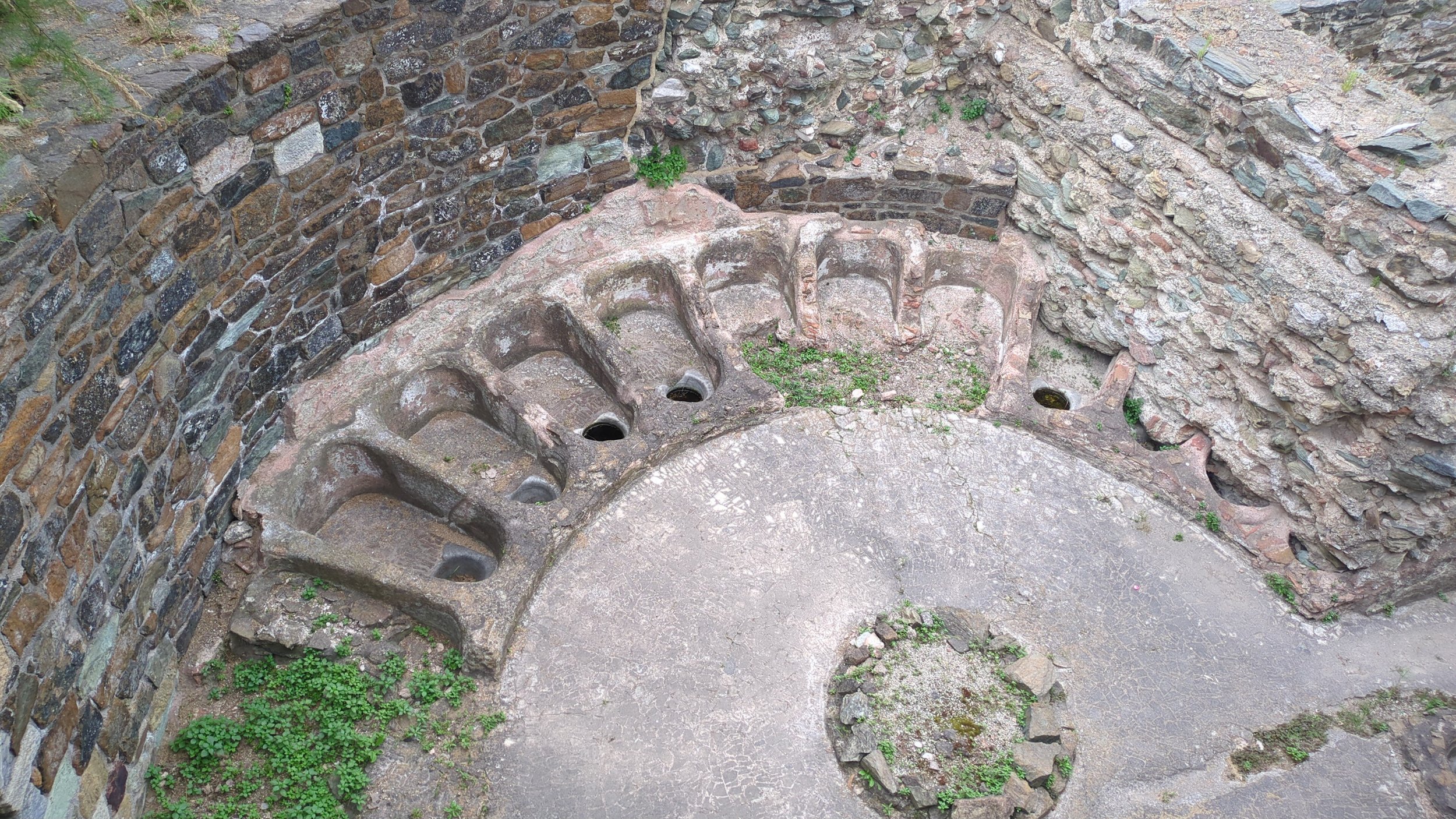





Tips and Tricks
There is so much that we did in this portion of the trip. We had two excellent resources for this portion of the trip. The best was Dimitrios with Tours by Locals. I’ve mentioned Tours by Locals on this site many times before because their guides are amazing and often incredibly helpful. We had initially booked with Dimitrios to take us to the recently opened Palace of Aigai and the Macedonian Tombs, but then reached out to him for our other side trip to Amphipolis. I’m so glad we did. His knowledge and enthusiasm for the sites was just amazing.
We booked the trip up to Stobi through Daytrip. Traveling from Greece to North Macedonia is a bit tricky - you have to go through passport control and most rental cars won’t let you take your rental from Greece to North Macedonia. So, we booked through Daytrip (which you’ll recognize from our Baltic states trip.) They have Stobi as a stop on their Daytrip drive from Skopje to Thessaloniki, so we were able to arrange a special trip that was round trip Thessaloniki to take us up there.
So, let’s start with Thessaloniki as a city. It’s huge and super busy. We stayed at the Infinity Sea View Apartment through Booked. It was an excellent location. The only difficulty was finding the key - we ended up getting help from someone working at the cafe below the apartment. The key is in a box near the door and the box pulls open in a weird way that it took us a while to figure out. But once we got in, we really loved it. Great views, excellent location, very comfortable.
Thessaloniki is a really impressive city. If you follow along the waterfront, you’ll come to the White Tower, which is quite lovely. Up from there is the archaeology museum. It seems like it’s a very big museum, but unfortunately a lot of it was closed (due to understaffing per Dimitrios.) But what was open was quite impressive and had a nice overview of the history of the city. The also had some really interesting history of the museum and how archaeology in the area has worked over the years. Walking up from there to the Arch of Galerius is a bit of a slog, but the Arch is quite lovely. From there we proceeded to the Roman Forum area. Unfortunately, the archaeological portion was closed, but the museum underneath was open and really nice. It had excellent information and was very well organized. One note about the Roman Forum - in the southeast corner is this interesting circular feature with this ring of oblong shapes. According to the museum, those are bathtubs. It’s the only bathing area with that design that has ever been discovered. It’s very cool. I would love to go back when it’s open.
There’s a ton of archaeology that Thessaloniki has uncovered in the process of trying to put in a subway system. It’s pretty amazing to just be wandering down the street and seeing these areas where the construction is stalled because there’s just a ton of archaeology that you can see in the workspace.
Another site that we almost missed was the Rotunda. You really should go in. It’s such a neat space. So, we’re not sure what it was built for originally. There is a theory that it was tied to Galerius and was built as a mausoleum. Or maybe it was a temple. It was eventually converted into a church, but then was converted into a mosque, and now it’s a public performance space. The changes that have been made to it over the years are visible in the stones of the building. Absolutely worth a visit.
We also stopped by the Church of Saint Dimetrius and the Church of Hagia Sofia. Both are ancient churches that are quite impressive and have some fun archaeology in the churches and the gardens around them.
The last thing we did before the end of our trip was to head up toward the Acropolis Walls of Thessaloniki. The only problem was it was uphill and taxis did not want to take us. So it was a bit of a hike. But the view is incredible, and we enjoyed a fantastic lunch at Wall by Wall. If I’m ever back in Thessaloniki, I’d love to have more time up here.







Aigai and the Macedonian Tombs
I think that in you’re in Thessaloniki and don’t take the time to visit Aigai and the Macedonian tombs, you’re really missing out. The work on the newly revamped palace complex has been incredible. The site itself is huge and it makes more sense to think of it as a capitol building complex instead of a palace. There are temples, symposia (a series of three interconnected rooms that were used for discussions,) public spaces, and even public terraces that had really good views. We also stopped down below the palace area to see the public space (theater probably) where Philip of Macedon was murdered according to legend. We had some really interesting discussions with Dimitrios regarding whether Alexander had a hand in the death of his father - the debate is there!
The palace has been really well restored. One of the most noticeable features are the floors. Some of the rooms have these really interesting red floors that seem to be unique to the site. The pebble floors in other areas look like other black and white pebble floors we’ve seen at other sites.
After our visit to the palace complex, we went to the Macedonia tombs. This includes the tomb that has been linked to Philip of Macedon. We can’t definitively state that the one tomb was that of Philip, but there are a number of reasons to believe it is. As we visited more museums related to the Macedonians, we became very familiar with their typical burial method - the bodies are burnt then the remains are placed in a box. That box is the placed in a tomb with some kind of crowns, either depicting oak (for men,) myrtle (for women,) or laurel (also for men.) The size, shape, and material indicate a lot about the person buried in that tomb. The tomb thought to below to Philip has two burials - both with heavy gold boxes and with gold laurels - one of oak and one of myrtle. The woman appears to have been of a woman who spent a lot of time riding horses, and one of Philips wives (who was said to have been buried with him) was Thracian. The size and material of the boxes also indicate people of great status. The decoration of the tomb is elaborate and it is quite extensive.
There are three other tombs in this complex. One is suspected to belong to Alexander III - a son of Alexander the great. There are two others that have not been connected with any one individual, but they are quite impressive. Even if these tombs didn’t belong to the royal family of Macedonia, they are worth visiting for the sheer scale of the tombs and number and beauty of the artifacts. The entire complex has been wonderfully preserved and the museum is amazing. The only downside is that it can be quite busy, but you can’t blame people for visiting.
We also visited the museum of Pella that has also been recently completed. It is really impressive. There are a number of incredible artifacts, including a whole set of tiles that had pawprints (which is just adorable.) There are more grave goods from other burials and you really get a sense of what burial customs for people of status looked like. You get the same crowns and boxes, but they are often smaller and made of silver or even bronze. There are also some pretty impressive mosaics that were brought in for preservation. Another common grave good was the gold burial mask. Do these look just like the Mask of Agamemnon in the Athens museum, that dates back to the Mycenaeans? Yes, they do. Then again, I guess if you’re making a gold funerary mask, it’ll end up looking like a gold funerary mask.
Near the museum is the archaeological site of Pella. It was the capital of Macedonia after Aigai. It was a very important city and was very wealthy. After it was sacked by the Romans, it became a Roman colony. It eventually lost prominence due to silting in of the lagoon. Without that direct access to the sea, it was no longer as useful. The preserved site is beautiful and also very worth a visit.




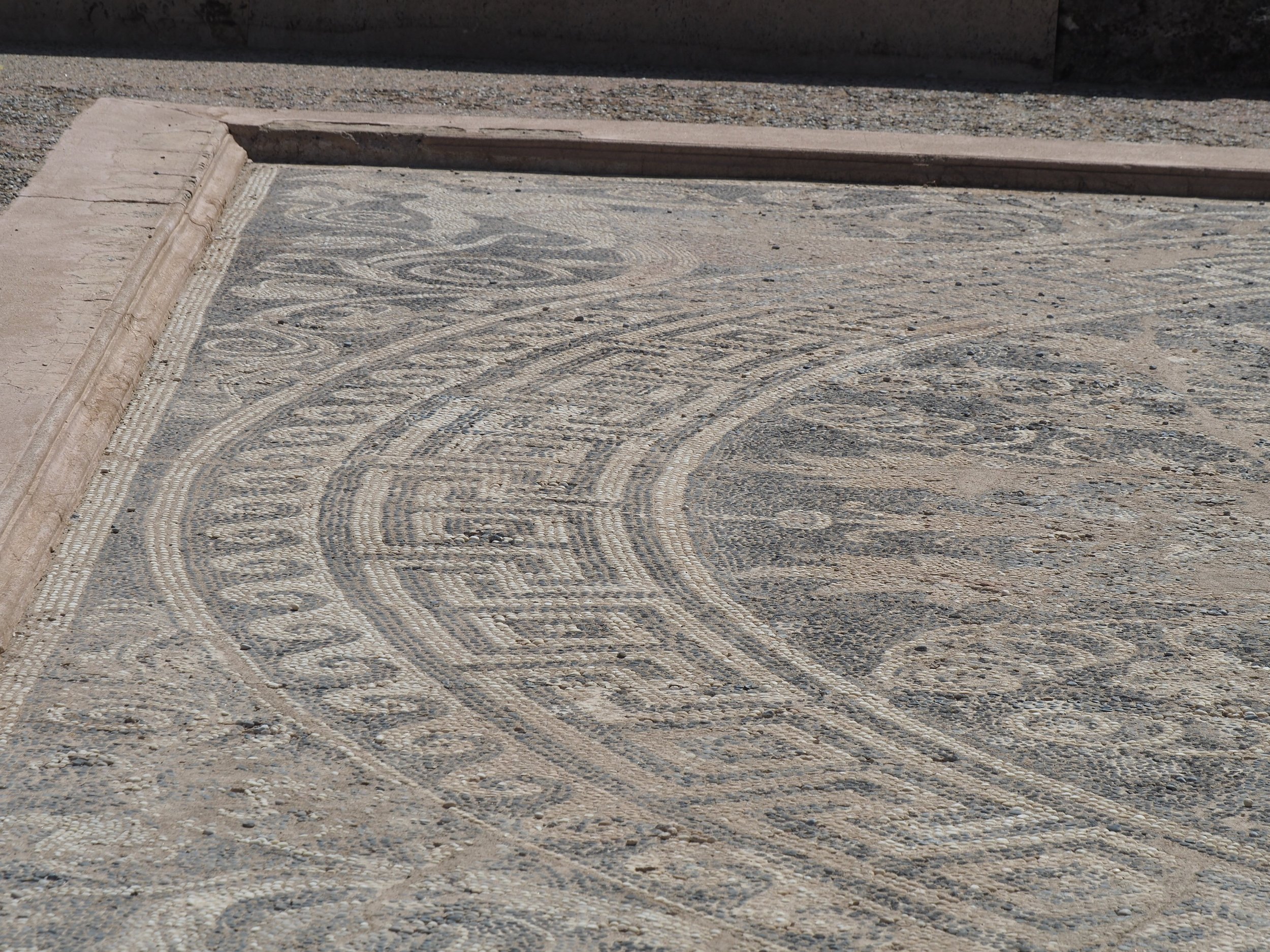











Stobi
Stobi was an important city in the ancient kingdom of Macedonia. It’s about half an hour north of the North Macedonia/Greece border. It was eventually conquered by the Romans (as was everywhere) and has some pretty impressive remains. The most well preserved buildings are the theater and the basilica. While there are remains of the Macedonian city, the largest section of the site that’s been preserved date to the Roman period.
The site itself is really nice. It’s well organized, and the free audio guide is very helpful. They only negative I’d say is that it can be a little challenging to figure out how to follow the path. There were also a couple times where we followed an open path to come to a dead end where it looked like we weren’t supposed to be there. But there was active work going on around the basilica, so that may have been the issue.
So, the basilica is the most impressive building. There are some really beautiful mosaics that you can see, including the peacock which is on the currency of North Macedonia.
Some other interesting features include a Jewish complex including a synagogue and a temple complex that was discovered that was dedicated to the worship of Isis and Osiris. It really shows how diverse the religious practices were in this region at the time.
It’s not a huge site and can probably be thoroughly visited in about an hour and a half. After we finished, our driver was passing by Stobi winery and he graciously stopped to see if they were open. It was amazing! Looked right out of Napa Valley. We did a wine tasting, picked up some wine (I highly recommend their bubbly,) and headed back. So, if you have some free time, definitely take a tour of Stobi.


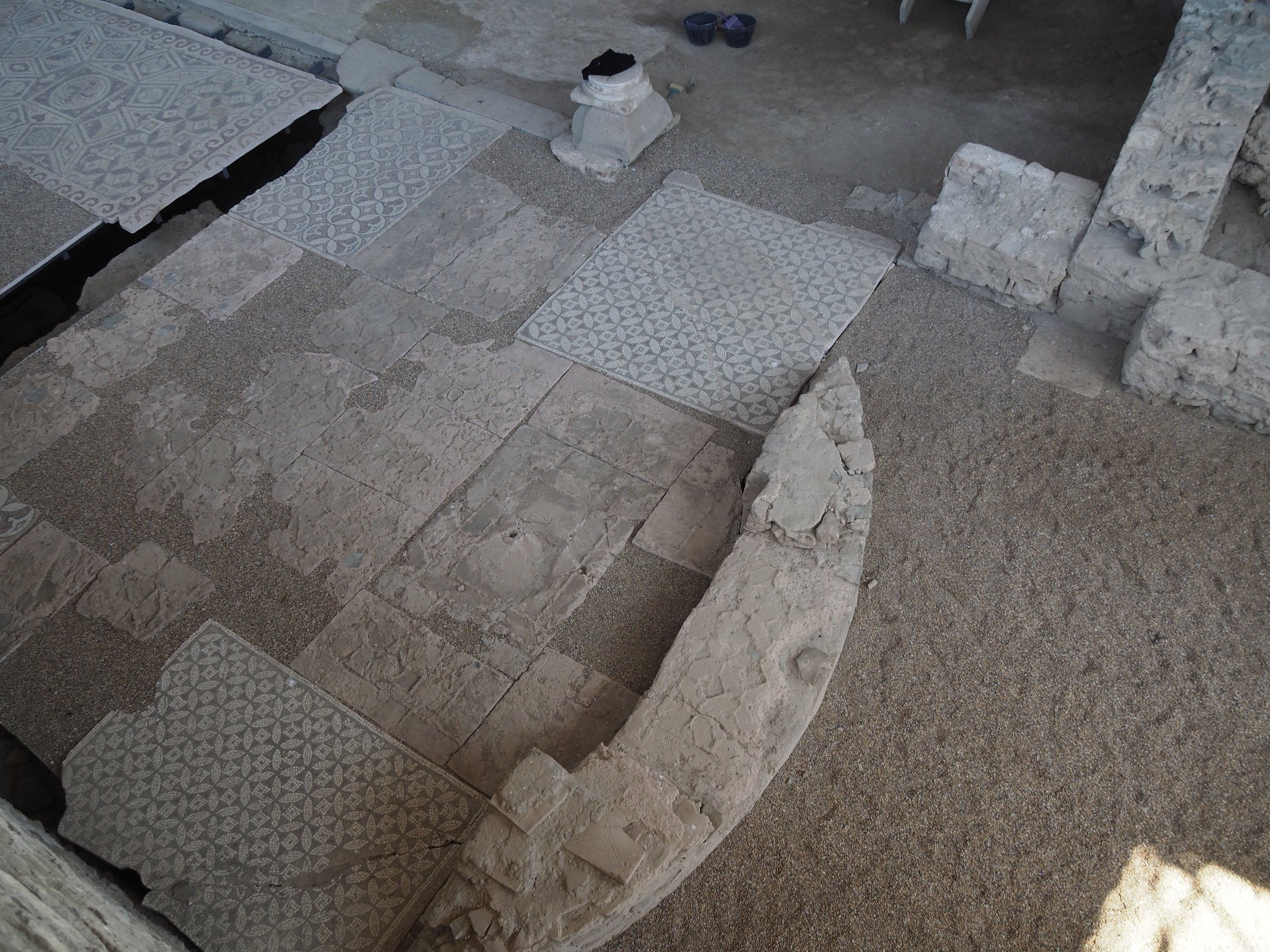




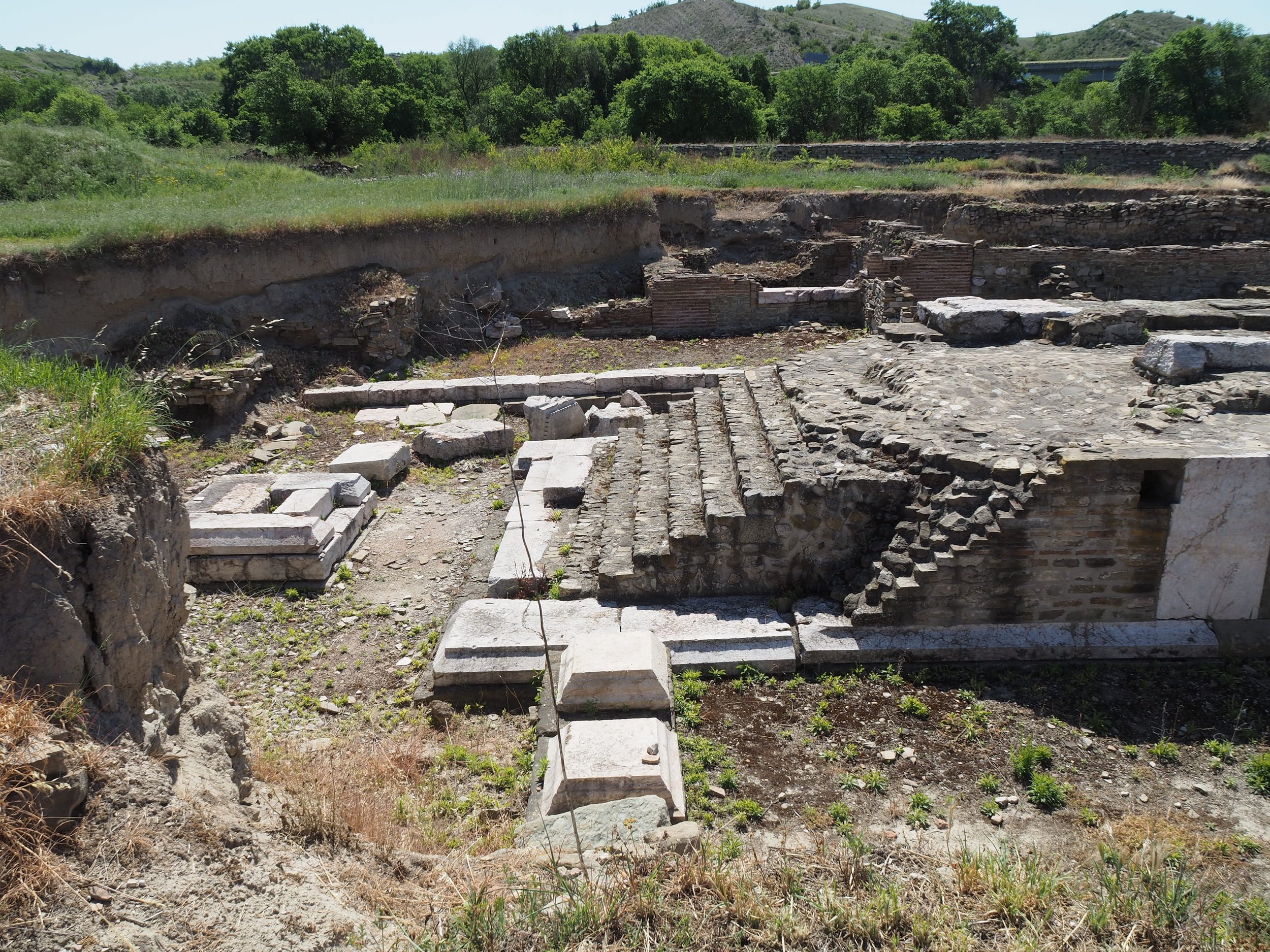

Amphipolis
Amphipolis is a city east of Thessaloniki. Our guide from Aigai, Dimitrios, was able to take us around. He is amazing because he’s buddies with the people who work at the site, so we had access to a few sites that can often be locked. We started at the Lion of Amphipolis - the lion that originally been at the top of an important tomb that had been found in the river and returned to the edge of the city. It’s very tall. Is it a bad lion? Sort of - in the delightful way that ancient lions can be. It’s very impressive. Love the lion.
We then went to the edge of the city walls. Ancient Amphipolis was originally founded by the Athenians since it was right on the border with Thrace (we were so close to Bulgaria.) There were mines in the hills nearby and the Athenians wanted access to that. So the Athenians were there, fighting with the Thracians, and then it became a fight between the Spartans and the Athenians. Amusingly, the people of Amphipolis sided with the Spartans (mostly because they were tired of paying taxes to Athens.) All of this backstory is to explain that Amphipolis was built with large and reinforced city walls to protect it.
We then proceeded to the main site of ancient Amphipolis. We started at the remains of a Hellenistic house which had quite lovely frescoes. It’s normally locked, so we were lucky that Dimitrios knows the site manager(?) who was able to let us in. It was really interesting because the decoration of the house actually matches the design of the city walls. There was also a well and the remains of some decorative flooring. It is really worth visiting if you can.
After that we went to the other part of the site that is normally locked. That is the gymnasium. It’s an impressively extensive site. There are the remains of the running area, the baths/sinks (with dents that came from the rubbing of countless limbs over so much time,) remains of the pipes to run the water, and some really impressive colonnades. It’s quite extensive.
Up the hill from the gymnasium, we came to the remains of the agora and the later buildings. The most impressive buildings in this section are the remains of the later Christian buildings. This includes a number of basilica with some really impressive mosaics - including possibly the best mosaic which depicts a spider. Absolutely love it. Another interesting thing about the remains of Amphipolis is how you can see how the city went through some serious battles over time. There are a number of walls built of whatever was at hand, and there are parts of the basilicas that are just cut through with a later constructed wall. It wasn’t just the Athenians against the Thracians, the Spartans versus the Athenians, and the conquest of the Macedonians (who used the port of Amphipolis to launch a lot of ships to travel east and conquer the world,) but it was also the Roman conquest and a huge battle between the Thracians and the Romans. The city eventually fell under the conquest of the Slavs and then of course the Ottomans. The cut of the basilicas was probably during the Slavic attacks.
This whole area was really lovely to wander. It has great views down to the river and the archaeology is quite impressive. If it’s a nice day, I could probably just hang out here for hours.
We finished up at the archaeological museum. Okay, I will now tell you the best story of the archaeological museum. I mentioned before that there was a time when the Spartans and the Athenians were at war over the city with the city taking the side of the Spartans. There was a Spartan general named Brasidas who was killed and buried in the city. During the construction of the archaeological museum, the actually found a burial dating to that period that indicated a high ranking person and was the only burial ever found within the city walls. So they found Brasidas, and his casket and burial wreath are visible in the museum, and you can see where it was found below the building. The museum itself is very nicely laid out. They have an excellent collection with some lovely mosaics, a nice collection of gold pieces including some nice jewelry, interesting ceramics, and of course the box and wreath of Brasidas.
So if you have the time and can make a trip to Amphipolis, I really recommend it. And thank you for reading about this trip. If you want more information to help you plan you trip, my contact information is in the footer!



